A JOURNAL OF CIVIL WAR EXONUMIA
By BRIAN W.
The US Civil War is regarded by many as the defining event in our nation’s history and a key turning point in the course of world events. It was fought for a variety of reasons, from union, to abolition, to states’ rights – but, ultimately, the undeniable horror of the war on both sides had the effect of unifying the United States in a way never before envisioned. As Civil War historian Shelby Foote notes:
“Before the war, it was said, ‘the United States are.’ Grammatically, it was spoken that way and thought of as a collection of independent states. [A]fter the War, it was always ‘the United States is,’ as we say [and think] today, [a unified whole]… And that sums up what the war accomplished. It made us an ‘is.’”
With respect to numismatic offerings relating to the war, there are so many options and avenues to explore, it would take 10 lifetimes to collect everything. My collection focuses on select, high end pieces with great designs, superior eye appeal and/or interesting histories. It’s currently a small assortment but one I hope you find interesting and fun.
Store Cards and Patriotics
Connecticut: Alfred S. Robinson, (F-120A-1d, R-CT-HA-16), 28mm: Alfred S. Robinson was a banker, broker and notary public who operated his business out of 309 Main Street, Hartford, CT. He was also a numismatist and avid collector of coins, medals, autographs and engravings. Two different sales of his collections were held in 1861; the first by Bangs Merwin & Co. of New York City on January 28-29th and the other by Leonard & Co. of Boston on April 16th. He was also responsible for the striking of quite a number of medals and tokens, including replicas of famous colonial issues such as the Rosa Americana twopence and Brasher doubloon. It is believed the die work for almost all of his pieces was executed by the well known Boston engraver, Joseph H. Merriam.
Robinson issued two versions of his store card, with one being unique. The reverse of the other version shows a replica of the 1737, 1739 Connecticut coppers associated with Samuel Highley. According to Robinson’s price list published in 1861, he made 20 examples in silver and 150 examples each of copper, brass, tin, plated and nickel. Today the composition is usually classified as silver, copper, brass, cupronickel, white metal and lead. The below piece is a cupronickel example. Although not evident in the pictures, it has very nice luster for the composition, especially on the obverse and an almost wood-grain appearance on the reverse. NCG graded it MS63.
Connecticut: Aaron White Calendar Medal, (F-280A-1b), 38.1mm: This is a highly unusual store card in both size and denomination and was only recently added to Fuld. It’s around the size of a silver dollar and has a price of 25 cents. It’s also the only issue from the town of New Boston, CT. The issuer, Aaron White, was a teetotaling attorney and banker and was considered somewhat of an eccentric. He hoarded coins and precious metals. Upon his death he had acquired at least four and a half tons of copper cents (at a value of $8,000).
The reverse of this piece shows important dates in US history, including the issuance of the Emancipation Proclamation on January 1, 1863. Given this is an 1863 calendar medal, it is almost certainly the first numismatic reference to the Proclamation. The below example is struck in brass with attractive rose, mint green and blue toning. It’s certainly a rare item and is graded MS65 by NGC.
Massachusetts: Merriam’s “Good For A Scent,” (F-115E-1a), 19mm: Joseph H. Merriam was a noted die sinker in Boston and produced many exceptional tokens and medals in the mid-nineteenth century, including what is arguably the most famous Civil War token (and definitely the most creative way around the restrictions the government placed on the private issuing of “cents”). It’s listed as number 83 in the book, 100 Greatest American Medals and Tokens. The present example has wonderful medium brown color with ample areas of original mint red and proof-like blue toning. It’s graded NGC MS65 BN.
New Jersey: B.W Titus, (F-885A-2b), 19mm: This token is common, but hard to find in choice grades. It is the only issue from my hometown of Trenton, NJ. The Benjamin W. Titus firm lasted until 1899 when the business fell on hard times. The Titus wool mill was sold at a sheriff’s sale in August of that year to the First National Bank of Trenton for $5,000, subject to encumbrances of $21,000. The present example is housed in an NGC MS64 holder.
New York: Hussey’s Message Post, (F-630AK-2a), 19mm: George Hussey, a bank employee, started his messenger service in the 1850s. He catered solely to banks and other businesses and promised immediate delivery of documents and essential papers. Mr. Hussey operated his message post until 1877, when he retired and sold the business to Robert Easson. In addition to private tokens, Hussey’s also issued private postage stamps and currency.
This exceptional token features a pictorial on both obverse and reverse along with the slogan “Time Is Money” which is also seen on Hard Times tokens. This piece has great color and surfaces and a proof-like appearance. It’s in an NGC MS66 RB holder.
Rhode Island: City Fruit Store / Burnside, (F-700G-2a), 19mm: This store card is a great piece featuring a reverse of Union General Ambrose Burnside. He formed and led the 1st Rhode Island Volunteer Infantry and later went on to become governor of Rhode Island and a US Senator. His distinctive style of facial hair came to be known as “sideburns,” a term we still use today. The example below has considerable original mint red remaining. Graded NGC MS 64 RB.
Patriotic: United We Stand / Thistle, (F-449/471 a), 19mm: This token has great violet and blue toning and superb luster which are not fully evident in the pictures. Although it’s advertising goods and services, because a specific merchant and town are not mentioned, Fuld classifies this as a patriotic rather than a store card. Some collectors refer to these hybrids as “half cards.” It’s graded NGC MS 65 BN.
Patriotic: Washington Cincinnatus / All Seeing Eye, (F-114b/228 a), 31.3mm: A numismatic strike by John Lovett, this is one of the rarest die pairings of all Civil War Patriotics (perhaps as little as 7 known). This item features an obverse portrait of George Washington and compares him with Lucius Quinctius Cincinnatus. Cincinnatus was a Roman general who was later appointed dictator and called upon to lead Rome’s armies against rival tribes on the Italian peninsula. After promptly defeating his enemies, Cincinnatus, like Washington, renounced his near-absolute authority to return to his life as a farmer.
The reverse contains the “All Seeing Eye” or “Eye of Providence;” symbolic of God watching over and protecting the Union. The “Eye” is similarly featured on the Great Seal of the United States and appears on the One Dollar bill. This piece has amazing pink/orange and blue toning with blazing luster and strong prooflike surfaces. NGC graded it MS 65 RB; which is undergraded in my opinion. It could easily be an MS66PL star.
Medals, Medalets and Related Exonumia
John Brown Medalet, (Dewitt-SL-1859, WM), 30mm: John Brown was a radical abolitionist and religious zealot. He is perhaps best known for his raid on the federal armory at Harper’s Ferry, VA (now West Virginia). He and a small band of followers seized the armory with the intent of arming slaves and starting an insurrection in the South. The armory was quickly re-taken by the Marines, commanded by then US Colonel Robert E. Lee. Brown was tried, convicted and hanged for inciting servile insurrection and treason against the State of Virginia. The news about the raid on Harper’s Ferry electrified North and South alike. While some saw Brown (both in his time and today) as nothing more than a home-grown terrorist, many believed he was a martyr for the cause who played a major role in galvanizing the country towards an inevitable war.
“John Brown’s Body” became a popular Union marching song and, although some historians believe it was written about a different John Brown, it became popularly associated with the fiery abolitionist. The tune to “John’s Brown’s Body” was later used for The Battle Hymn of the Republic.
The piece below is in white metal and dated 1859 (the year of Brown’s execution). It is considered fairly rare. I’ve heard estimates anywhere from as little as 15-25 known to as high as 100-200 extant. Attractive, high end pieces are certainly scarce. This one is NGC MS 64.
US Mint Medal: 1861 Oath of Allegiance, (Julian C-2, Baker-279), 31mm: This medal was struck to commemorate the oath of allegiance to the United States that all Mint employees took at the outset of the war. It’s not only a piece of Civil War history but numismatic history as well. Mint Director at the time, James Pollock, was the first of three directors to serve two non-consecutive terms, being re-appointed by President Grant in 1869. Pollock also pressed for the expansion and upgrading of the San Francisco Mint facilities.
Pairing the Oath of Allegiance reverse with a Washington obverse was good marketing on the part of the Mint as collecting Washingtonia was all the rage at the time. This example, struck in silver, is much scarcer than its non-precious metal counterparts. Both sides are deeply reflective with exceptional toning. It’s housed in an NGC MS65 holder.

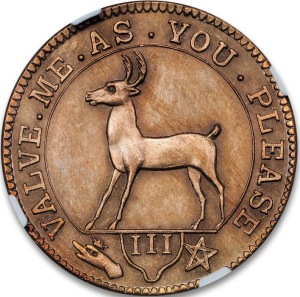
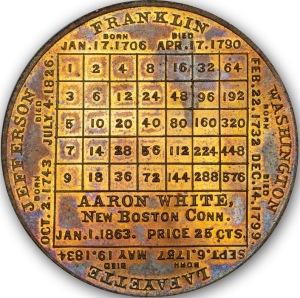
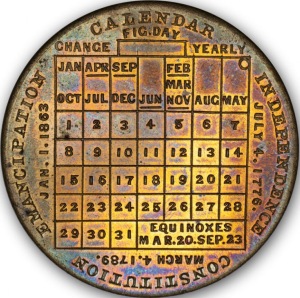
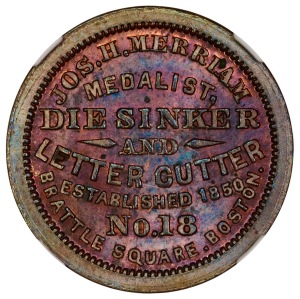

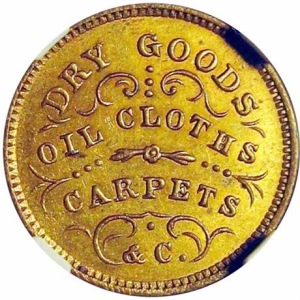
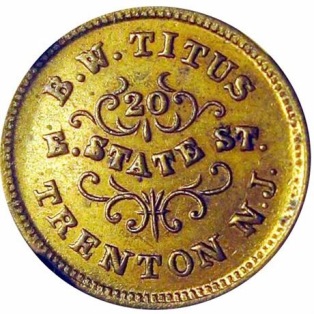
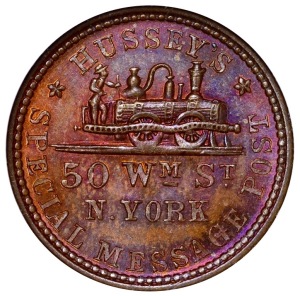
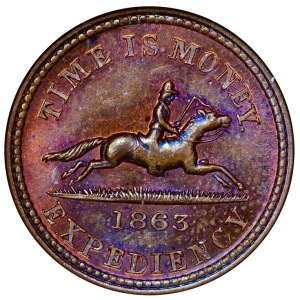
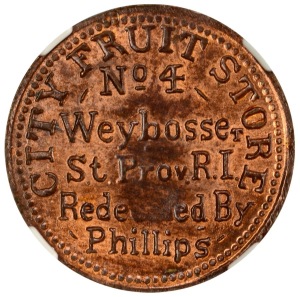


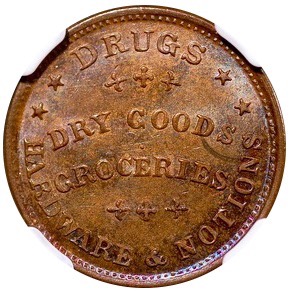
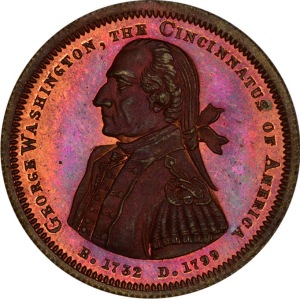
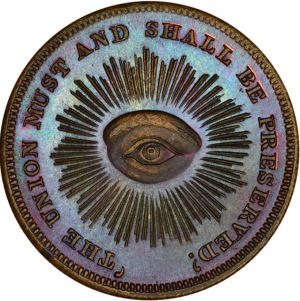

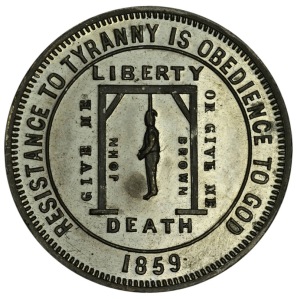
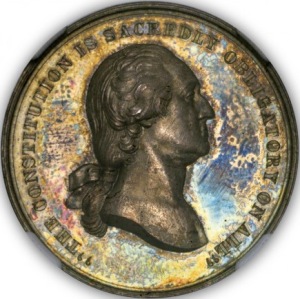

Great tokens, great information. Thanks.
LikeLike